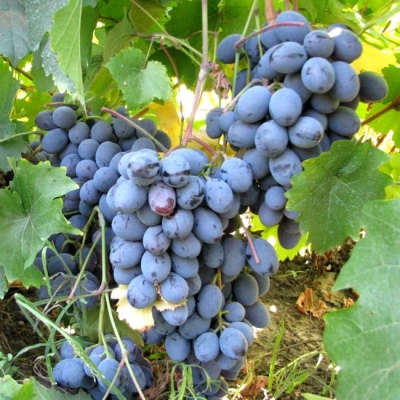
- Authors: NPO Bashkir
- Appointment: universal
- Berry color: Navy blue
- Taste: specific, varietal
- Ripening period: early
- Bunch weight, g: 120
- Density of the bunch: loose
- Appeared when crossing: Madeleine Angevin x vitis amurensis
- Year of approval: 1999
- Berry shape: rounded
When choosing a grape variety, many pay attention to those species that ripen earlier. One of the most popular is Bashkir. It is bred in many nurseries and is ideal for commercial cultivation.
Breeding history
The breeding of this variety was carried out in the experimental garden of the Bashkir Research Institute of Agriculture and Selection Field Crops. It is considered one of the earliest grape varieties. It is included in the State Register for the Russian Federation. Authors of the variety: Abdeeva M.G., Strelyaeva L.N. and Maistrenko N.V.
Description
The grape variety belongs to the early, the duration of the growing season is 160 days. Key features:
- characterized by active growth of bushes;
- the leaves have a dark green tint, the blades practically do not stand out;
- pubescence is practically absent;
- petioles are elongated, have a reddish-brown tint;
- the resulting clusters are medium, loose.
At the same time, the variety is characterized by resistance to cold, the plant can withstand up to -23 ° C.
Ripening period
Fruit ripening time is August. The main thing is to choose a suitable landing site. The timing of ripening also largely depends on how well the care is carried out. For example, some actions will significantly increase the rate of fruit formation.
Bunches
The resulting clusters are medium, their maximum weight is 120 g. The clusters are loose and branched. With an average yield, they hang a little, so proper care involves tying.
Berries
The berries are medium in size, dark blue and round in shape, the flesh is juicy and fleshy. However, the berries are very fragile, therefore, due attention should be paid to the processes of transportation and storage.
Taste
The tasting score is 8.4 points. That is why many people pay attention to this variety. The sugar content is 14.3%, the acidity value is 1 g / l. The purpose of the berries is universal.
Yield
The yield indicator is 140 kg / ha. If you follow all the recommendations for planting and care, the value rises to 190 c / ha.


Growing features
To obtain maximum yield, you must follow the basic recommendations for growing:
- in the first year after planting, loosening of the soil and abundant watering should be carried out;
- it is necessary to carry out timely processing of grapes from diseases and pests.
Landing
The planting process should start with soil selection. The cultivar thrives best on light soil.From it, the plant can get all the nutrients. Grapes require a sufficient amount of moisture and oxygen. Chernozem or mixed soil, which is represented by a combination of sand, minerals and organic matter, is considered ideal.
When these recommendations are followed, problems with the rapid appearance of the first fruits will not arise. The landing itself is carried out in several stages.
- Each bush requires an 80 cm recess.
- The bottom is covered with a layer of humus and nutrient soil.
- The bottom is compacted, potash fertilizers and wood ash are added. By adding all the layers, the depth of the fossa will be 50 cm.
- In the central part of the hole, a small elevation is made, where the seedling is placed.
- The next step is to compact the soil and water abundantly.
- After the earth dries out, the top layer is slightly loosened to a depth of 10 cm.
The bush should be watered several times at intervals of 2 weeks. Then periodically it is necessary to carry out loosening and mulching of the soil.

Pollination
One of the problems is related to pollination. The plant has exclusively female flowers. Therefore, early flowering grapes should be planted nearby.
Pruning
Correct and timely pruning of bushes can significantly increase the volume of the crop. It also has a positive effect on the taste and quality indicators of the resulting fruit.
The process is carried out exclusively in the autumn. The procedure consists in the complete removal or pruning of annual shoots. If the branches start to hurt, they are also cut off.



Frost resistance and the need for shelter
The frost resistance index of the variety largely depends on the correct preparation for the winter period. After full ripening, the vine has a brown color, after a decrease in temperature, it remains warm, when bent it begins to emit a characteristic crunch.
Branches that have a greenish tint must be removed during autumn pruning: they will not be able to overwinter, and if they die, they can cause damage to the plant by fungi and mold.

Diseases and pests
The variety is characterized by high resistance to diseases and pests. Proper care eliminates the likelihood of damage and death of the plant.
Only with timely processing of the culture can the possibility of an infection be eliminated. The first spraying is recommended for spring pruning, a solution of ferrous sulfate is used. It is very important to deal with pests in a timely manner, as they greatly deplete the bush.

If a grape is exposed to any disease or insect, this always affects its appearance.
Storage
The harvested fruits can be used in a variety of ways. Most often, berries are used immediately after harvest, but they can also be frozen. The recommended storage temperature is about 4 ° C. Particular attention must be paid to the transportation process, strong impacts can damage the skin.











































































